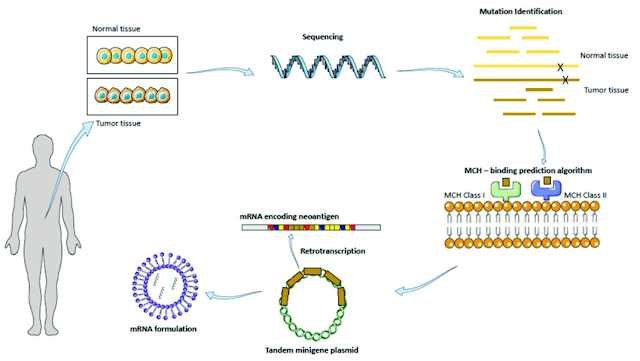 |
| Promising Clinical Trials for Personalized Melanoma mRNA Vaccine [Image Source: researchgate] |
A pioneering personalized mRNA vaccine for melanoma, the deadliest form of skin cancer, is currently in Phase III clinical trials in the United Kingdom. Developed by Moderna and Merck Sharp and Dohme (MSD), the vaccine aims to enhance the immune system's ability to recognize and eliminate remaining cancerous cells after surgical removal of the tumor.
How the Vaccine Works:
- The vaccine, mRNA-4157 (V940), is tailored to match the unique genetic signature of each patient's tumor.
- It prompts the body to produce proteins or antibodies that target markers (antigens) found exclusively on the patient's cancer cells.
- Administered alongside pembrolizumab (Keytruda), an immunotherapy drug that boosts the immune system's cancer-fighting capabilities.
Trial Details and Results:
- Led by the University College London Hospitals (UCLH), the UK trial aims to enroll 60-70 patients across eight centers.
- Patients eligible for the trial must have had their high-risk melanoma surgically removed within the last 12 weeks.
- Phase II trial data demonstrated that patients with serious high-risk melanomas who received the vaccine alongside Keytruda were nearly 50% less likely to die or experience cancer recurrence after three years, compared to those who received only the drug.
Potential Impact and Future Applications:
- Experts anticipate that this personalized vaccine could potentially cure melanoma and transform cancer treatment.
- The vaccine is also undergoing trials for other cancers, such as lung, bladder, and kidney tumors.
- If successful, the treatment could provide a lasting cure for various cancer types, significantly enhancing patient outcomes and survival rates.
Prevention and Early Detection:
- Strategies to reduce melanoma risk include protecting the skin from excessive sun exposure, using sunscreen, and avoiding tanning beds.
- Regular self-examination of the skin and moles, along with professional skin checks, can help detect melanoma early.
- The ABCDE rule (Asymmetry, Border irregularity, Color variation, Diameter > 6mm, and Evolution of moles) is a useful guideline for identifying potentially cancerous moles.
About Melanoma Facts and Statistics:
- Melanoma originates from melanocytes, the cells that produce melanin pigment.
- It is the most lethal form of skin cancer, responsible for most skin cancer-related deaths.
- The World Health Organization (WHO) reports approximately 132,000 new cases of melanoma worldwide each year.
- Risk factors include excessive UV radiation exposure, fair skin, numerous moles, and a family history of melanoma.
As clinical trials progress and more data becomes available, these innovative therapies could offer renewed hope to patients with life-threatening cancers, ultimately improving survival rates and quality of life.
